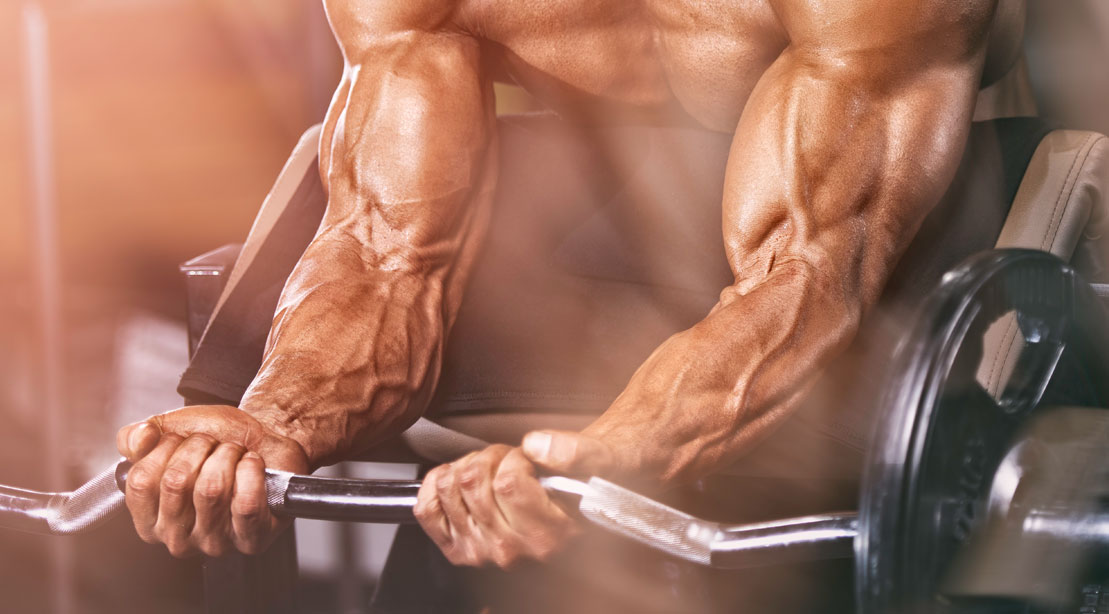28-Days-to-Lean Meal Plan
With the right plan and the right discipline, you can get seriously shredded in just 28 days.
Read article

Incomplete – that’s the average score bodybuilders earn for forearm workouts. Most trainers don’t work them at all; others throw in only a couple halfhearted sets of wrist curls. And yet, the forearms are the most visible muscle group, supplying ready evidence of iron-willed toil. They’re also among the largest, because if we count the muscles from hand to elbow, the tally is 20. Follow our lessons to turn these 20 into automatic attention grabbers, and raise your forearm “incomplete” to an A+. Class is in session.
MISTAKE #1: TRAINING NEGLECT
EXPLANATION
The majority of bodybuilders don’t do direct forearm work, whereas many others do four or fewer sets of wrist curls. No segment of the iron game neglects forearms more than the very champions we feature in these pages. And therein lies a problem — you’re not a pro bodybuilder. Phil Heath’s DNA allows him to grow two of the world’s best lower arms by merely gripping bars during upper-body exercises. You’re not so lucky. The assertion that you’ll get enough forearm stimulation by simply training everything else often holds true for Mr. O competitors, but rarely does so for the rest of us.
SOLUTIONS

MISTAKE #2: NEGLECTING GRIP STRENGTH
EXPLANATION
Regardless of your forearm size, many trainers suffer from a weak grip, hindering their performance in pulling exercises, such as deadlifts and rows. We recommend you use wrist straps on back day to make sure that your hands don’t give out before the targeted muscles, but you may not want to always rely on such aids. You’re only as strong as your weakest link, and frequently the link that breaks first is the one closest to the weights.
SOLUTIONS

MISTAKE #3: INSUFFICIENT EXERCISE VARIETY
EXPLANATION
The only equipment most trainers use during a forearm workout is a barbell. It’s our favorite tool, too, but you need to have others in your tool box. Imagine if you only did various types of barbell presses for your chest, workout after workout, year after year. As great as bilateral pressing is, you’d miss out on the muscle stimulation of exercises done with dumbbells, cables and specialized machines. And so it is for forearms.
SOLUTIONS

MISTAKE #4: LITTLE EMPHASIS ON STRETCHING AND CONTRACTING
EXPLANATION
A wrist curl is a short movement, but most trainers shorten it even further by doing quick reps that only hit the midrange, skipping the stretches and contractions. Many reverse-wrist-curl reps are not even half reps and are focused entirely on the middle of the movement.
SOLUTIONS

MISTAKE #5: INSUFFICIENT REP VARIETY
EXPLANATION
Most bodybuilders stick to the mid- to high-rep level for forearms, doing sets of 10-15 reps. This is the sweet spot, but it’s not the only spot. Like calves, forearms are used to a lot of low-intensity drudgery throughout each day, and are therefore very adaptive. To keep them growing, keep them off balance with a variety of rep schemes.
SOLUTIONS

LESSONS LEARNED
✔ Train forearms with 6-12 sets as regularly as other bodyparts.
✔ If grip strength is a concern, do grip-specifi c exercises in a separate routine.
✔ Use dumbbells, cables and machines on occasion.
✔ Emphasize the stretch and contraction during each rep.
✔ Vary your rep ranges and include supersets to up the intensity.
FLEX